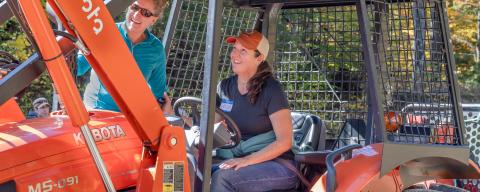When spring is fast approaching, it’s time for tractor maintenance.
Remember that good spring maintenance starts with good fall maintenance!
If your tractor has sat in a barn all winter (or out in the snow) it probably will need some basic maintenance before spring use. Here is a quick checklist to make sure your equipment is in working order.
As this is a basic checklist, you can also consult the owner’s manual for your tractor. It will indicate any other items specific to that piece of equipment that might need maintenance or attention.
Checklist
• Consult owner’s manual
• Update maintenance log
• Check the tires for cracks, wear, or dry rot. If needed, inflate to the correct PSI as marked on the tire. Replace any tires that are unsafe or in disrepair.
• If your tractor has loaded tires, check that they are still in balance and with enough liquid.
• Check oil and, if needed, change the oil and oil filter (if not changed in the fall).
• Inspect the air filter, use pressurized air* to clean filter of dust and debris. Inspect for rips, tears, or holes. Replace filter if it can’t be cleaned sufficiently or is damaged.
• Check in the engine area for rodent nests or damage. You can use pressurized air to clear any leaves, debris, or nests. Be sure to check fins on radiator.
• Grease all points on loader (if applicable). Check your tractor manual for other grease points. Be sure to use grease recommended in tractor manual.
• Check that the seat is in working order and hasn’t been damaged by rodents or weather. If applicable, check that the seatbelt is present and in working order.
• Check hydraulic fittings and hoses for fluid leaks, cracks, and abrasions in the lines.
• Check the fuel level.
• Check headlights and taillights. Ensure “slow moving vehicle” sign is attached and visible.
• Check coolant and hydraulic oil and fill to marked level (if needed).
• Test the battery and check for corrosion. Clean the top surface of the battery using a dry rag to clear grease, moisture, and debris. Top off cells with distilled water, if applicable.
• Check belts for cracks, dry rot, or tears. Replace if needed. Check tension, tighten if needed.
• If your tractor has a cab, check and clean air filters. Wash glass panels, fill washer fluid, and replace windshield wipers.
*When using pressurized air, be sure to use eye protection and a respirator.
Extension Services & Tools That Help NH Farmers Grow
Newsletters: Choose from our many newsletters for production agriculture
Receive Pest Text Alerts - Text UNHIPM to (866) 645-7010


